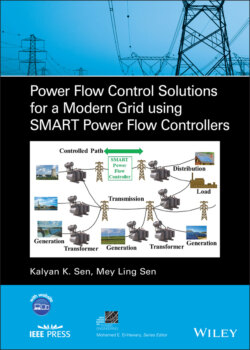Читать книгу Power Flow Control Solutions for a Modern Grid Using SMART Power Flow Controllers - Kalyan K. Sen - Страница 23
1.4.1 Defining a Cost‐Effective Solution
ОглавлениеThe voltage/power flow compensation in the transmission/distribution network results in a higher asset utilization. The types of solutions may vary from using transformer and LTCs to power electronics inverters. Each of these solutions is based on engineering trade‐offs. In particular, as the response times of various solutions increase from slow (3–5 s) to medium speed (<1 s) to fast (<0.010 s), there is a corresponding increase in the solution’s life‐cycle costs (installation, operation, and maintenance), complexity, and impracticability of relocation. Other important features to consider are reliability, robustness, efficiency, component non‐obsolescence, and interoperability.
It is recognized that the superior response capability of a power electronics inverter‐based solution may be beneficial in applications where voltage flicker is caused by an electric arc furnace load and dynamic voltage restoration is required for critical loads. The final selection of a solution, however, depends on knowing the functional requirements and analyzing the cost and benefit of each available solution that means the most features at the least total cost. In the case of a simple voltage regulation at a utility bus, an SC may be an adequate solution, whereas for an arc furnace load, the power electronics inverter may be the best solution.
Consider the three cases (Case 1: “do nothing;” Case 2: “do something;” and Case 3: “go above‐and‐beyond”) of solutions for voltage regulation.
Figure 1-24 Cost versus features in various solutions (Case 1: “do nothing;” Case 2: “do something;” and Case 3: “go above and beyond.”)
Case 1 represents a “do nothing” approach where the solution cost (i.e. cost #1) is zero; but the lost opportunity cost (i.e. cost #2), which is the cost of not providing a solution, such as penalty for causing a voltage flicker may be the highest as shown in Figure 1-24.
Case 2 represents a “do something” approach where the solution cost (cost #1) increases as the number of features in the solution increases. For example, a shunt‐connected reactor or capacitor with a breaker may seem to be the simplest solution where the solution cost (cost #1) is greater than zero; however, the lost opportunity cost (cost #2) that accounts for the (1) penalty for not providing var support and (2) penalty for creating voltage flicker may be less than that in Case 1.
Case 3 represents a “go above‐and‐beyond” approach where the solution cost (cost #1) increases further as the number of features in the solution increases. When various other solutions options, such as SynCon, SVC, STATCOM, and so on with faster response times are considered, the solution cost (cost #1) goes up further; however, the rate of decrease in lost opportunity cost (cost #2) may be less than the rate of increase of the solution cost (cost #1). So, the optimum cost is where the total cost is the minimum. This is the intersection of the regions where Case 2 ends and Case 3 starts.
Better solutions provide primarily better regulation of voltage, thus create less flicker and less penalty. However, in the case of a STATCOM, the voltage is so well regulated that a secondary benefit emerges; the wear‐and‐tear on the electrodes in an electric arc furnace application becomes more uniform than in any other solution; this results in less frequent replacement of the electrodes, which reduces the overall operating cost of the plant. When all the costs, benefits, and penalties are taken into account, there may be a case where the cost of the added features of a particular solution outweighs the benefits. In between, there lies the cost‐effective solution that provides the most features at the least total cost.
Consider the solution cost (C1) is a combination of a fixed cost (FC1) and a variable cost (m1 x), which is given by
(1‐8)
where m1 is the slope 1 and assumed to be 0.4, x is the number of features, and FC1 is the fixed cost 1 and assumed to be 0.
Consider the opportunity cost (C2) is a combination of a fixed cost (FC2) and two variable costs (m2 x and 2−wx ), which is given by
(1‐9)
where m2 is the slope 2 and assumed to be –0.2, x is the number of features, FC2 is the fixed cost 2 and assumed to be 1.3, and w is the weighting factor and assumed to be 1.
Therefore, the total cost (C) is given by
(1‐10)
where C1 and C2 are given in Equations (1-8) and (1-9), respectively. All the parameters may be assigned suitable values to represent cost versus features of a solution realistically.
